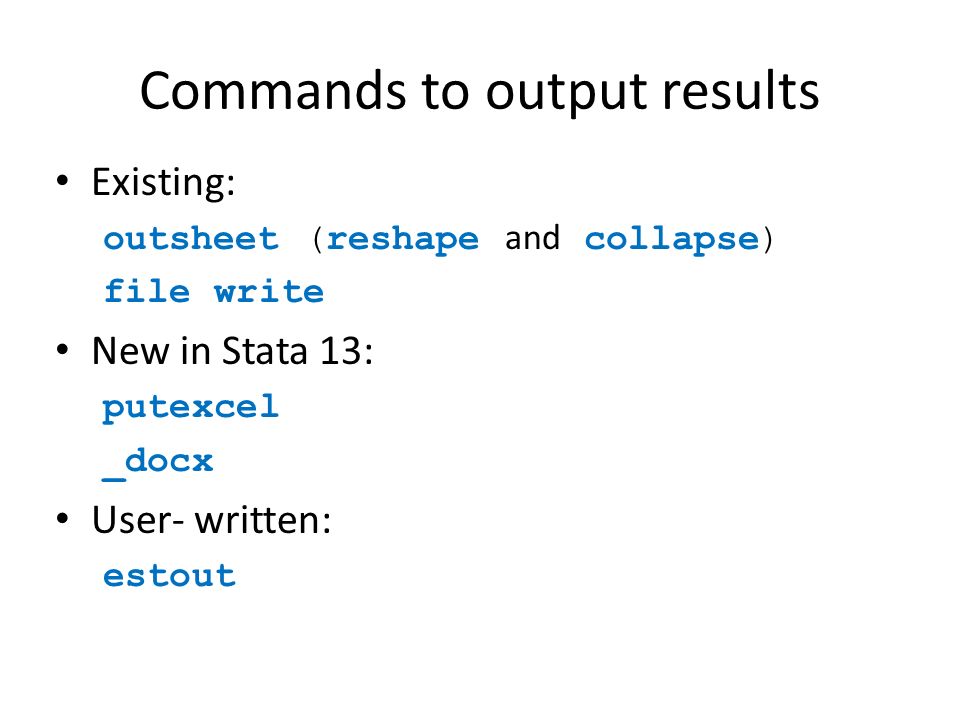

If you want to choose a different category as the base, add b and then the number of the desired base category to the i: If rep78 is missing, all the indicator variables are also missing. 1b.rep78 is a special case: it is the base category, and always set to zero to avoid the "dummy variable trap" in regressions. The other indicators are constructed in the same way. To see how it works, try:Īs you see, 3.rep78 is one if rep78 is three and zero otherwise.

This works in most (but not all) varlists. The set of indicator variables representing a categorical variable is formed by putting i. Stata can create such indicator variables for you "on the fly" in fact you can treat them as if they were always there. This is even more important for categorical variables with no underlying order, like race. However, you might want to include a set of indicator variables, one for each value of rep78. Thus it would make no sense to include rep78 in a regression as-is. However, these numbers only represent categories-a car with a rep78 of five is not five times better than a car with a rep78 of one. Categorical (Factor) VariablesĬonsider the variable rep78: it is a measure of the car's repair record and takes on the values one through five (plus a few missing values). The fact that logit models are easy to run often masks the fact that they can be extremely difficult to interpret. Just be sure to interpret them properly, as well discuss later. If you prefer odds ratios to coefficient add the or option. Logit goodRep displacement gear_ratio weight foreign

The logit command runs logistical regression. A good rule of thumb for logistic regression is that you need at least 15 observations per predictor and hopefully many more. There are other variables that may seem like good candidates for predictors, but keep in mind you only have 74 observations. We'll include displacement and gear_ratio because they're the only technical data we have about the car's engine (the most likely thing to break), weight as a measure of load on the engine, foreign just because it seems to be an important characteristic of a car. Now let's examine what predicts a car's repair record. Make an indicator variable goodRep which is one for cars with rep78 greater than three (and missing if rep78 is missing): Logistical regression is just as easy to run, but we need a binary dependent variable. Looks like American consumers in 1978 liked big cars and didn'tĬare about fuel efficiency, a much more plausible result. Now mpg is insignificant but weight is positive and highly significant. Important to control for the size of the car by adding weight to the regression: Possibly have some missing variable bias here in particular it's probably Our theory (or common sense) we first look for better empirical results. Like any good researcher, when our empirical results contradict The negative and highly significant coefficient on mpg suggests that AmericanĬonsumers in 1978 disliked fuel efficiency, and would pay to avoid it! WhetherĪ car is foreign or domestic seems to be important, so throw

Mileage in 1978 using a naive "hedonic pricing" model (i.e., we'll presume the price depends on the characteristics of the car). Let's estimate how much consumers were willing to pay for good gas
COLLAPSE STATA PLUS
In the list plus a constant (unless you add the noconstant option). Is the dependent variable, and it is regressed on all the others It always needs a varlist, and it uses it in a particular way: the first variable The regress ( reg) command does linear regression. Thus if you can do a simple linear regression you can do all sorts of more complex models. Stata has many, many commands for doing various kinds of regressions, but its developers worked hard to make them all as
COLLAPSE STATA CODE
Remember the code you add goes after sysuse auto and before log close. Start a do file as usual, and save it as regression.do: We'll use the auto data set that comes with Stata throughout. This article will teach you the fundamentals of running regressions in Stata.


 0 kommentar(er)
0 kommentar(er)
